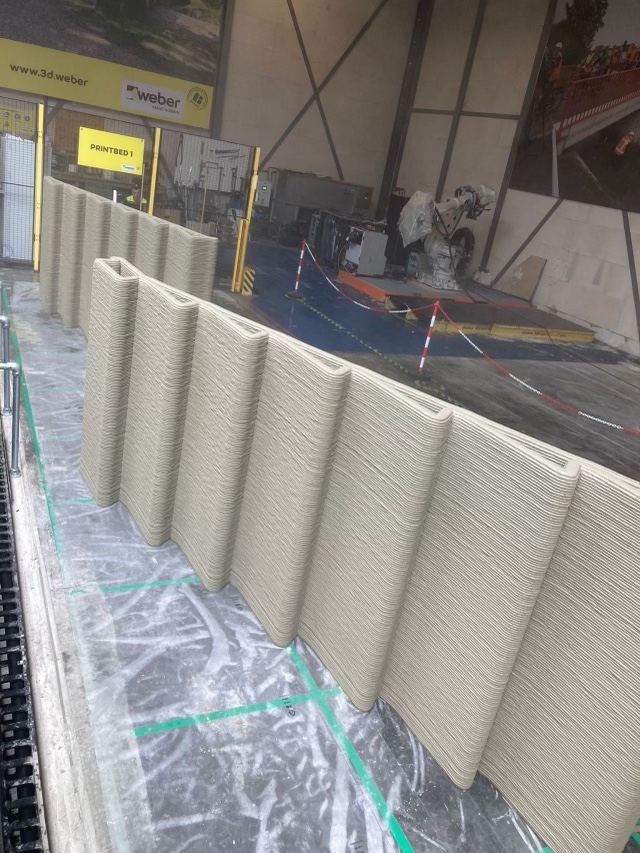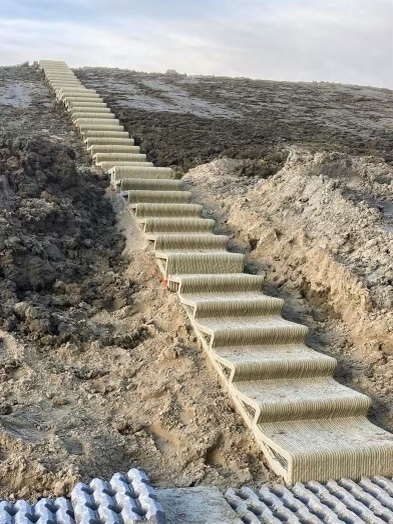As with bridges, people seem to have a particular affinity for 3D printed stairs. With good reason: aside from just being eye-catching structures, the ability to print things like bridges and staircases could be a significant factor determining the long-term success of the additive construction sector.
Although stairs produced via additive manufacturing (AM) are becoming more commonplace lately, there’s still something quite unique about the latest such project, launched by Saint-Gobain: they’re engineered with parametric design. The project reduced CO2 emissions by 50 percent and construction time by eight weeks, compared to traditional methods.
The French industrial conglomerate, which has shown great enthusiasm for adopting AM techniques over the past few years, is making the product available via its Weber Beamix concrete mortar additive construction facility in the Netherlands. Weber Beamix also collaborated with Dutch construction engineering firm Witteveen + Bos on the project.

Specifically, these are embankment stairs, which parametric design seems especially well-suited for. By using parametric modeling — basically, a process that creates designs automatically based on parameters — staircases can be molded to precisely whatever sloped natural environment they’re going to be built on. Not only does this allow builders to minimize material waste during the construction process, it could, in the long run, also be greatly beneficial to enhancing the safety of the end-products. Moreover, the use of parametric modeling in this case could lead to wider adoption of the tool within additive construction.

Of course, there’s the cost savings, too. And at about 30% cheaper than a regular prefab staircase, it’s not surprising that the stairs are already installed at an impressive 20 locations, in the Netherlands and the UK. Finally, customers have the option of designing the staircases themselves on Weber Beamix’s website, or sending the company dimensions and/or a drawing via email.

As I noted in the first paragraph, any additional function of conventional construction that can be taken on by additive beyond printing walls is a big deal. This is true for a variety of reasons, including fairly standard ones, like the reaching of larger economies of scale for the supply chains involved. Even more importantly, though, from a long-term perspective, every additional kind of structure that can be printed increases the possibility that, eventually, entire construction projects can be printed from top-to-bottom.
Additionally, the incorporation of parametric modeling aids in that same effort. The possibilities for increasing architectural sustainability opened up by the ability to design and print structures directly into the landscape are endless. The more that software utilizing parametric modeling is used in additive construction, the more potential there also is that additive could at some point in the future be seen not merely as equal to conventional construction, but preferable to it.
Images courtesy of Saint-Gobain
Subscribe to Our Email Newsletter
Stay up-to-date on all the latest news from the 3D printing industry and receive information and offers from third party vendors.
You May Also Like
3D Printed Heat Spreader Could Improve Efficiency of Electronics
The low-hanging fruit for decarbonization has long been improving the efficiency of existing systems, hence the justification for LED lights and ENERGY STAR certified appliances. While such minor moves are...
3D Printing News Unpeeled: Marine Gearboxes, 3D Printed Motors and $1.7 Million in Seed Funding
UK based Equipmake just released their Ampere-220 e-axle system. The system, which is meant for high performance electric cars, was similar to one released on the Ariel HIPERCAR. It has...
CEAD Unveils 36-Meter-Long 3D Printer for Abu Dhabi’s Al Seer Marine
CEAD, a Dutch original equipment manufacturer dedicated to large-format 3D printers, has unveiled what it claims to be the world’s largest robotic arm-based 3D printer. At 36 meters long and...
3D Printed Biocomposites Could Help Reduce Marine Plastic Pollution
Concerns about the impact of plastic litter and microplastics in the oceans are at the forefront of environmental study. For decades, the marine environment has suffered from the degradation of...




































